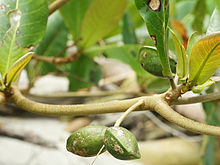Terminalia catappa
| Terminalia catappa | |
|---|---|
 |
|
| Scientific classification | |
| Kingdom: | Plantae |
| (unranked): | Angiosperms |
| (unranked): | Eudicots |
| (unranked): | Rosids |
| Order: | Myrtales |
| Family: | Combretaceae |
| Genus: | Terminalia |
| Species: | T. catappa |
| Binomial name | |
|
Terminalia catappa L. |
|
| Synonyms | |
|
List
|
|
Terminalia catappa is a large tropical tree in the leadwood tree family, Combretaceae, that grows mainly in the tropical regions of Asia, Africa, and Australia. It is known by the English common names country-almond, Indian-almond, Malabar-almond, sea-almond, tropical-almond and false kamani.
The tree grows to 35 m (115 ft) tall, with an upright, symmetrical crown and horizontal branches. Terminalia catappa has corky, light fruit that are dispersed by water. The seed within the fruit is edible when fully ripe, tasting almost like almond. As the tree gets older, its crown becomes more flattened to form a spreading, vase shape. Its branches are distinctively arranged in tiers. The leaves are large, 15–25 cm (5.9–9.8 in) long and 10–14 cm (3.9–5.5 in) broad, ovoid, glossy dark green, and leathery. They are dry-season deciduous; before falling, they turn pinkish-reddish or yellow-brown, due to pigments such as violaxanthin, lutein, and zeaxanthin.
The trees are monoecious, with distinct male and female flowers on the same tree. Both are 1 cm (0.39 in) in diameter, white to greenish, inconspicuous with no petals; they are produced on axillary or terminal spikes. The fruit is a drupe 5–7 cm (2.0–2.8 in) long and 3–5.5 cm (1.2–2.2 in) broad, green at first, then yellow and finally red when ripe, containing a single seed.
The tree has been spread widely by humans, so the native range is uncertain. It has long been naturalised in a broad belt extending from Africa to northern Australia and New Guinea through Southeast Asia and Micronesia into the Indian Subcontinent. More recently, the plant has been introduced to parts of the Americas. Until the mid 20th century, the tree has been extensively used in Brazilian urban landscaping, since being a rare case tropical deciduous, their fallen leaves would give a "European" flair to the street. This practice is currently abolished, and the "amendoeiras" are being replaced by native, evergreen trees.
...
Wikipedia
